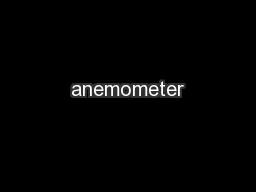

wind vane Francis Beaufort Listen as your teacher tells the story of Francis Beaufort Do you know how meteorologists determine wind conditions Record your ideas in your notebook Read the introduction and look for key ideas ID: 605097
Download Presentation The PPT/PDF document "anemometer" is the property of its rightful owner. Permission is granted to download and print the materials on this web site for personal, non-commercial use only, and to display it on your personal computer provided you do not modify the materials and that you retain all copyright notices contained in the materials. By downloading content from our website, you accept the terms of this agreement.
Slide1Slide2Slide3
anemometer
wind vaneSlide4
Francis Beaufort
Listen as your teacher tells the story of Francis Beaufort.
Slide5
Do you know how meteorologists determine wind conditions?
Record
your ideas in your notebook.Slide6
Read the introduction and look for key ideasSlide7
How will you design instruments to measure wind speed and direction?Slide8
Wind vanes and anemometers
Look at the photographs on page E-77. Do
you think each tool measures wind speed, wind direction, or both? How
might
each
tool work to measure the wind
?
Share your thoughts with the class.Slide9
Why might a stopwatch be needed to measure a
wind
’s rate of speed?‘What
length of time should we use to measure wind speed? Revolutions per minute? Per hour?
Share your thoughts with the class.Slide10
Complete the procedure and record your dataSlide11
SCORING GUIDE: Designing InvestigationsSlide12
Share your data with the class
What patterns do you see?
Are there similarities in the data?
Do the data fall within a certain range?
What might explain these similarities or differences?
Are the wind measurements similar? Why or why not?
What does this tell you about the wind or about the instruments that were used?
How could we test our ideas? Slide13
What is one change you made to your instrument?
How did it improve the design?
Brainstorm any design challenges that still remain.Share your thoughts with the class.Slide14
Scientific careers in weather
L
ook at the skills for the scientific career you chose to focus on, and mark those that you have mastered.Slide15
Analysis question 1
Evaluate your group’s two instruments by completing the
following table.Slide16
Analysis question 2
What do the more successful wind-measurement instruments have
in common?Slide17
Analysis question 3
You designed and tested your anemometer and wind vane at
school. Imagine using them on a ship, as Francis Beaufort did. a. What factors might be different on a ship than at school?
b
. Describe how you would adjust the design
of
your instruments
so that
they would work
well
on a ship.Slide18
How will you design instruments to measure wind speed and direction?Slide19
Key vocabulary definitions
Anemometer
- An instrument used to measure wind speed.Wind vane - An instrument used to measure wind direction.